Photo
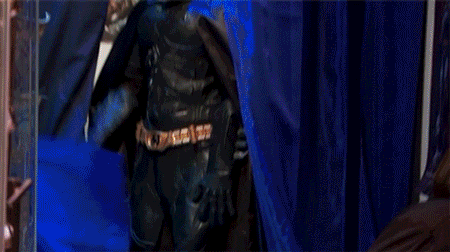
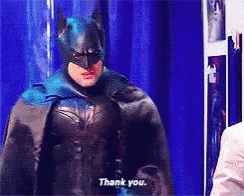



Maybe the greatest moment in television history.
22 notes
·
View notes
Text
Crisis on Infinite Earths #4
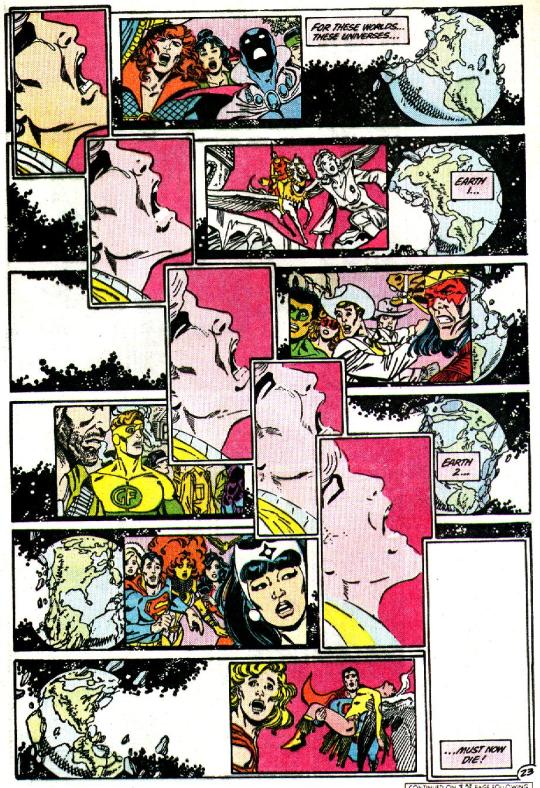
Rereading some classic event comics for a couple things. Was really struck by this page from Issue 4 of Crisis on Infinite Earths by Marv Wolfman and George Pérez. The layout has such a great sense of movement, carried through the descending panels of Pariah, the character cursed to watch universe after universe die (and you thought we had it bad).
Meanwhile to his left and right we see Earths 1 and 2 being more and more devoured by anti-matter (which is never not disturbing), while the heroes of those worlds look on. Their powerlessness is demonstrated both in their posture -- recoiling in shock -- and the relatively tiny panel sizes they inhabit. This is a page that is telling you all is lost.
(These early issues often give the destruction its maximum possible punch by depicting it through a series of slowly worsening panels. They’re like a How To book for depicting a process dramatically in comics.)
4 notes
·
View notes
Text
The Tragic Thing

Ad Astra director James Gray, profiled in The New Yorker:
“He used to memorize the worst paragraphs of his reviews—the criticism stoked some inner furnace that drove him to become a Great Man. Now he didn���t look at the stuff. He had found a new creative lodestar in the time he spent with his wife and kids. As the brass rings had fallen away, however, he hadn’t lost his drive to make beautiful movies, to touch an audience, because—why? Gray had puzzled over that, until he decided that the answer was, quite simply, that he cared. Caring for other people was the essential human privilege, he now believed. Caring was what both artists and audiences put into an exquisite work. The tragic thing, he decided, wasn’t caring about something no one else seemed to appreciate; the tragic thing was when you stopped caring, got too cynical, grew afraid to let yourself be seen to care and be cared for. “The key is to get more personal, not less,” Gray told me.
0 notes
Text
Shazam and the Power of Childhood Trauma

While I realize Avengers is pretty much the only thing super hero trending right now, last week I had the chance to finally see Shazam -- a movie I had almost no confidence in, as I just couldn’t quite crack the idea.
But I was really surprised at the quality of Henry Gayden’s script, particularly in the way it creates such a strong (and painful) parallel between Billy Batson/Shazam and his nemesis Doctor Sivana. Both Billy and Sivana faced terrible experiences of rejection as children. And that experience motivated Sivana to find a way back to the Rock of Eternity and the O.G. Shazam, who declared him unworthy, to seek revenge first on him and then on his family, which was pretty much just as awful to him.
Meanwhile, Billy’s response was to hunt for the mother that abandoned him, which pretty much everyone around him said was um, maybe not the best idea, given that she basically left him wandering around a carnival at age what, 7? But when he finally finds her, there’s this incredible moment where instead of asking what happened or why she abandoned him -- At a carnival? Really Mom? Are clowns not already scary enough? -- he instead apologizes. “You know I wasn’t trying to run away,” he tells her, in this plaintive insistent way that suggests he really has spent his whole life worrying about what he’s put his mother through.
It’s devastating and also such a great insight into what we do with childhood trauma, the way that the sheer mystery of it -- Why didn’t anyone ever want to play with me? Why did my father always yell at me? Why did that teacher always mock me? -- causes us to fill in the blanks by blaming ourselves. Their responses make no sense, e.g. parents do not leave children at carnivals, therefore it must be our fault.
It’s understated in the film, we get just that one line and we move on, but that’s all that we need. Or at least me, anyway.

Please, talk amongst yourselves.
Maybe there’s something in there about the difference between a hero and a villain in stories, too. A villain takes trauma, blames it on others but ultimately needs to learn to accept the horrors of his past.
A hero takes trauma, blames it on themselves and ultimately needs to learn it wasn’t right and it wasn’t their fault.
117 notes
·
View notes
Text
Great Scene: The Station Agent
This morning as part of research for a project I was re-watching The Station Agent (w/d Tom McCarthy, 2003). It has so many strong, unusually quiet moments in it.
And I came upon this little moment where protagonist Fin (Peter Dinklage) is approached by a little girl. I just love the course of the dialogue; it feels so true to the way children act and think.
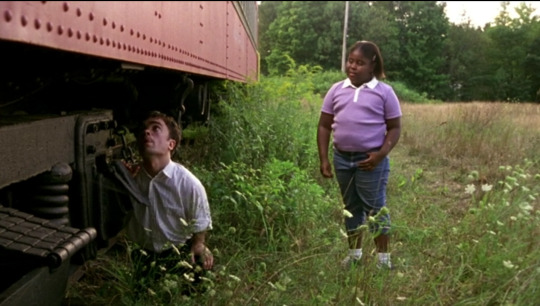
Cleo walks up as Fin inspects the underside of a train car.
Cleo: Hey what are you doing?
Fin: I’m searching the trucks for the company name.
Cleo: Well these are trains not trucks.
Fin: The wheels on the trains are called the trucks.
Cleo: What grade are you in?
Fin: I’m finished with school.
Cleo: Are you a midget?
Fin: No.
Cleo: Where do you live?
Fin: In the depot.
Cleo: My name’s Cleo.
Fin: My name’s Fin.
Cleo: Bye.
Cleo runs off.
You gotta love a scene that ends with a child randomly running off.
1 note
·
View note
Text
Hello to the Stories

At one point I walked into a bookshop, and found The Lord of the Rings, a book I love. I turned to the place where Gandalf is dead. The bereaved companions have found their way to Lothlórien and, on the first night, they hear the others sing laments for the Wizard. The laments are in Elvish and when some ask Legolas, the Elf, to translate, he refuses, saying that the grief was too near, a matter for tears and not yet for song.
I read it over and over and over, standing at a bookshelf, holding a heavy book, in a shop in the middle of the city.
Hello to the need for shelter.
Hello to the stories that shelter us.
Pádraig Ó Tuana, In the Shelter: Finding a Home in the World
0 notes
Text
THE WICKED + THE DIVINE: 1923 AD AKA A WORK OF ART(IFICE)

This issue is the Peakiest of Peak Gillen -- Gillen to the Power of Peak to the Power of Peak, if you will, #MathisCool. It’s a comic book masterpiece of research, reference and storytelling and I’ve been so daunted at attempting to comment on that it’s taken me months to make the attempt. You only climb Everest once, people! (Shut your mouth, Nat Geo.)
WAGNER VERSUS WARHOL, FIGHT!
In format the issue involves a back and forth conversation/rap battle between high and low art. On the one hand, we have novelistic chapters rich with description. “The island looked like a threat, a fist of rock that had forced its way through the waves.” The island and Ananke both...
Then we cut to what at first glance seems like your standard comic book, but in fact is actually a riff on the early days of film, complete with title cards (which themselves get so silly the font might as well be comic sans #IllBeHereAllWeek) and everything shot in a wash of black, white and brown, except for the splashes of red at the scenes of death—victims’ blood, Lucifer’s apple, and my favorite, the red seaweed around Neptune.

Love that red seaweed.
The heart of the plot follows a similar back and forth, as the elitist “classic” artists, the TS Eliot/Ezra Pounds and Ginny Woolf-ish-types of the Pantheon, want to kill the more popular art types, the Shirley Temples and Buster Keatons and Robert Johnstons, to initiate a nightmare scenario that will supposedly give them control over the zeitgeist of the future. It’s an incredibly disturbing take on some of the giants of the early 20th century -- and one Gillen found based in fact.
It’s fascinating, too, for as much as the real object of venom is the truly popular artists, the movie star types with their simplistic narratives and opium for the masses, the elitists focus on killing figures who from our perspective sit far closer to them – Lucifer (F. Scott Fitzgerald), Poseidon (Ernest Hemingway), Dionysius (Pablo Picasso) and the Morrigan (James Joyce). I wonder if it’s something about the chaos those specific figures represent, the way that their particular forms of art end up undermining not only the structures but internal belief system of the modern world. If Baal-Et-Al’s idea is to work with Joe Goebbels to coopt pop culture for their own We Will Keep Control project, in a sense a Picasso or Joyce was doing the reverse, presenting in the formats of the elites only to deconstruct their validity. (Gillen’s notes on the Morrigan point in this direction. Also, his description of Set as coming off “a little like Tahani from The Good Place made me laugh out loud.)
In the end our good guys will stop the bad using their own popular media, film from a train, which was in real life the very first motion picture, and terrified people back in the day for exactly the reason that they feared the train was real and was going to leap off the screen and kill them all.

Writing perfection.
HISTORY IN REPETITION AND RHYME
As we’ve seen throughout these specials, we get lots of echoes between periods here. Lucifer is once again the first one killed, the Morrigan is once again a character all about voice and drama (I love his self-narration so much, please sir can I have a spin-off?), the Norns are still trying to figure everything out, Susanoo=Dandy Baphomet, complete with his own complicated dating relationship (those rings made out of light, though, such a pristine beauty of a moment that Baph never gets), and Woden is once again a gross racist hack misogynist -- that submarine has got to be phallic, right? -- who has stolen his tech powers from someone else to produce content that is entirely derivative while secretly playing the gods and being used by Ananke.
There is also another mechanical creature, “Little Brother”, which we see only for a few panels, and that is not nearly enough because it is an adorable looking flying squid. (SCREW YOU BABY SHARK, BABY FLYING SQUID IS EVERYTHING.) Ananke also works from her standard playbook here, the Prometheus Gambit – you can gain some life if you kill others, which Baal et al will then use for bat#!% crazy purposes, which of course is also part of her plan.
And Minerva is also once again a child who seems maybe to be working with Ananke. It’s clear right from the start that the whole Shirley Temple schtick, lots of Yays and Gollys, is just an act, part of her “character”. And we get a glimpse of the real her again at the end.
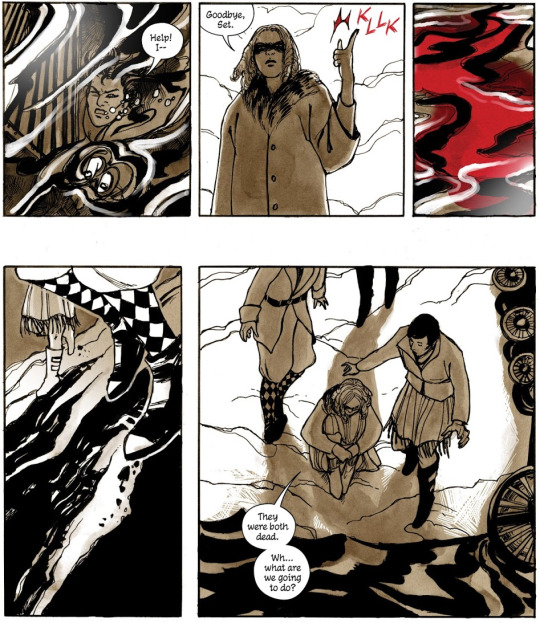
That doesn’t have to mean she’s in league with Ananke. (Just read the next arc; she’s totally in league with Ananke.) But she also comes to know what happened to Verdandi, when she wasn’t with the group that discovered him. (Dude: She’s totally in league with Ananke.) And it gives her an excuse to leave Morrigan at precisely the right moment for him to get murdered by Ananke. (Yes, exactly, because she’s in league with Ananke.) And she will kill Set herself without a second thought; it’s all still just hint and innuendo (UGH NO IT’S NOT STOP), but given what we’ve just learned in the present day that’s all we need for now.
Meanwhile Baal is in some ways the opposite of ours, a racist white elitist who dismisses James Baldwin-type Amon-Re as incapable of being an artist given his “nature”, and Set is her own thing too, a snobby name-dropping Virginia Woolf. Most intriguingly, the Norns have internal divisions that break them down, which make me worry a little bit for Cassandra and her friends.
Best take care of your family, Cassie. Remember, in #WicDiv no one is just a sidekick…
CREATURE(S) IN EBONY
This is the second special where the Fall of the Gods involves the introduction of a new being created by the gods by way of a classic Ananke “Definitely Don’t Do This (wink wink)”. In 1831, Lucifer and Morrigan resurrect Hades to create an energy vampire that after killing them merged with Woden Shelley to create Steam Punk Elsa. This time the being – again a woman – is described as “looking like some ancient ancestor of the Metropolitans, but made of living poetry and bleak lightning rather than simple metal.” Which sounds an awful like the 1831 Creature.
She also emerged from “an ebony luminescence with streaks of blue beyond blue”, which again, sounds a lot like Mary Shelley Elsa Frankenstein.
Almost 92 years later we’ve heard nothing from her. But Kieron never forgets anything, INCLUDING YOUR BIRTHDAY, SO WATCH OUT. What could this all possibly mean…
ANANKIERON CHRISTIE
For me the most interesting element of 1923, though, is everything to do with Ananke. We come into the special, like the last two, knowing she is our Big Bad (probably, I don’t know you guys, I think in the next arc Kieron’s going to make me feel bad for her and I don’t want to). (No worries, he didn’t, or did he, wait, there are two Anankes now, I don’t know, what?)
But here for the first time we enter into the story alongside her. In fact, in that very first shot it almost seems like she’s looking right at us.
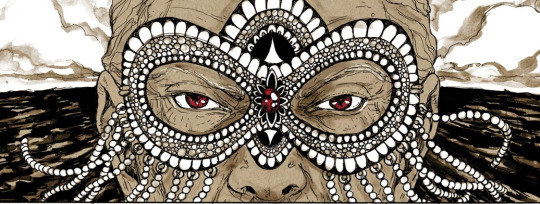
Time’s running out, she’s got to get to the murder-y and behead-yness stat, and this time we get to watch her do it. Awesome!
It’s almost like we’re partners in the exercise, even; right before they’re about to go in for dinner and discover Lucifer Ananke seems to stop and look at us again.
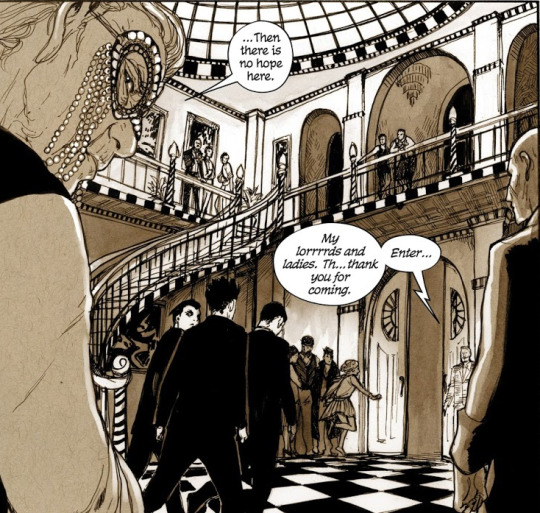
Us and the millennia-old serial killer of children--High fives all around!
For the last 30+ issues I’ve been asking why Ananke is she always wearing a mask, and now finally I get it: just like the Pantheon, she is an actor giving a performance.
Here specifically she presents herself as a classic Agatha Christie protagonist, finding herself along with everyone else in the Remote Place version of a locked room murder mystery and slowly working to uncover the truth of what’s going on while others continue to die. And Then There Was Fun!
Except in fact Ananke is not The Marple but Christie herself, author of the entire series of events that happen, which makes this to my mind pretty much the greatest Christie story ever, and also reinforces the belief of All of Us that Jessica Beatrice Fletcher is the Greatest Fictional Serial Killer that Ever Lived.
But wait, though. Doesn’t that make Ananke basically…a writer? Like um, this guy…?

But that’s crazy. We’ve spent the last five years with him. He’s fine.
I mean yes, both he and Ananke fashion fictional Big Bads (Note: this issue has absolutely no trace nor mention of a Great Darkness, despite the fact that this entire Pantheon has been around almost to their Use By) and also Ways to Save the World which motivate the characters down paths which lead to their eventual destructions.
And okay, true, in this issue Kieron does spotlight/ridicule parts of the storytelling mechanic, the machines characters are always trying to find/build/repair as nonsense.
Such rituals are actually simple. It is about will and art. The machines…in my experience, they are little more than props. All that matters is your action and intent. They killed so the world would die. You die so the world can live.
But still, if we were to accept that Ananke is Just Kieron’s, er, Mask, then it’s like this whole time he’s been the one doing terrible things to all these characters, including the characters that he made me want to love.


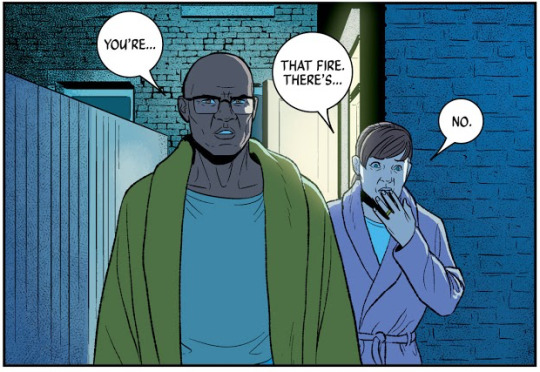
And then this question which I’ve been chewing on since 455 AD, whether the characters can ever be free of the roles they’ve been assigned, in a sense becomes a question about whether they can ever escape not Her but Him…
Or what about us? The Audience. The ones that Jamie and Kieron and the others are creating this for.
This isn’t And Then There Were None, is it? No, this is Temple of Doom. Kieron may be Mola Ram, but I’m the Ever-Hungry, Never-Satisfied G--D-- Kali.

All along, Kieron has thrown in these moments where we get glimpses of the broader world, the way it feeds on the Pantheon. And I can get to the end of 1923 AD and say there’s a fascinating battle going on here about the ethics and/or violence of being a writer. But maybe there are also deeper questions being asked of me as a reader.
Maybe the issue begins with Ananke looking at me like that for a reason.

STOP IT, ANANKE. YOU’RE MAKING ME UNCOMFORTABLE. LOOK AWAY.
WORLD WARS, IRL AND URL
A last point: 1923 AD is unusual for the degree to which it is haunted by something external, aka war. Even as the story takes place in the effervescent champagne bubble oasis of the Roaring 20s, both the nightmare that was World War I and the possibility of another war which is somehow impossibly much much worse than it hangs over the characters. That’s an insightful take on the period, but also an awe-full twist on the sense of doom that we’ve witnessed in the 21st century Pantheon, their own personal oncoming catastrophes expanded to the scale of disaster for the whole world.
It makes me wonder whether the last act of The Wicked + The Divine will involve something of a similar scale, whether the underlying momentum of the book has not always been toward the culture of celebrity, insofar as it engenders adoration, mob-think and a lack of fundamental care for and curiosity in one another, as sign of our own massive social crisis. (See: Brexit. Trump. The Fights My Dad Gets in on Facebook.)
Are we doomed? Do I still have time to tweet a thread about it? I really think it could make a difference, you guys.
3 notes
·
View notes
Text
Exhausted Kelpien Seeks Help Detaching His Threat Ganglia; Can Trade for Rare Plants, Best Friend

Out of the blue this afternoon I found myself randomly thinking about Saru, the wiry Odo-adjacent alien on Star Trek: Discovery played by the great Doug Jones.
In the first season the show established that his race, the Kelpiens, were a prey species on their planet, and as such had developed a hyper-sensitivity to any possible danger. Much like Spider-Man’s Spidey sense, when Saru sensed risk, threat ganglia would suddenly emerge along the back of his skull. But in the case of Kelpiens, that early warning system would generally make them grow anxious and timid, rather than quippy and with the thwips. (in fact the Fandom site on Saru says Kelpiens spend their whole lives in constant fear. Which kind of breaks my heart.)
This season a crazy series of events led Saru’s ganglia to suddenly fall away. And the belief of his species was that such an event was the precursor to death. The show in fact spent much of an episode first trying to save him, then saying goodbye -- only to discover that the whole story was a lie propagated by the predator species on the planet. In fact, the detachment of the threat ganglia gave Saru a courage and boldness that previously he had never known. it was like the ganglia were a parking break that had kept him in low gear.
And I was sitting in this Starbucks that I like and getting anxious as this guy who is sort of the Mayor of the place wandered around talking at the top of his voice to anyone who he was able to make eye contact with, even though he’s never bothered me and also even if he did, so what? And it just suddenly hit me what a metaphor Saru’s ganglia are for the shades of danger, judgment or threat we all unconsciously project onto others, even when there’s no reason to. We “borrow trouble”, as a friend likes to say, and man alive can it hamper our ability to move and live in the world. What an incredibly liberating thing it would be for those judgments and anxieties to simply fall away.
And yet -- and this is where the ganglia analogy is dead-on -- it can be so hard to let go of those judgments and fears. We grew them early on out of some need as our very own defense mechanism. And now you want to get rid of them? What are you, crazy? How will we survive without them? Just because the Mayor has never come up in front of me and start shouting obscenities at me while he pounds my hands to a pulp with a full-size hammer that he somehow carries in his front pocket doesn’t me he never will.
Saru knows what I’m talking about, don’t you Saru?
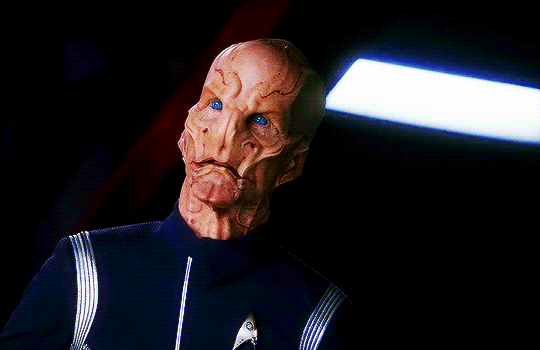
(God those things are gross.)
2 notes
·
View notes
Text
THE WICKED + THE DIVINE CHRISTMAS ANNUAL AKA LOVE ACTUALLY ACTUALLY
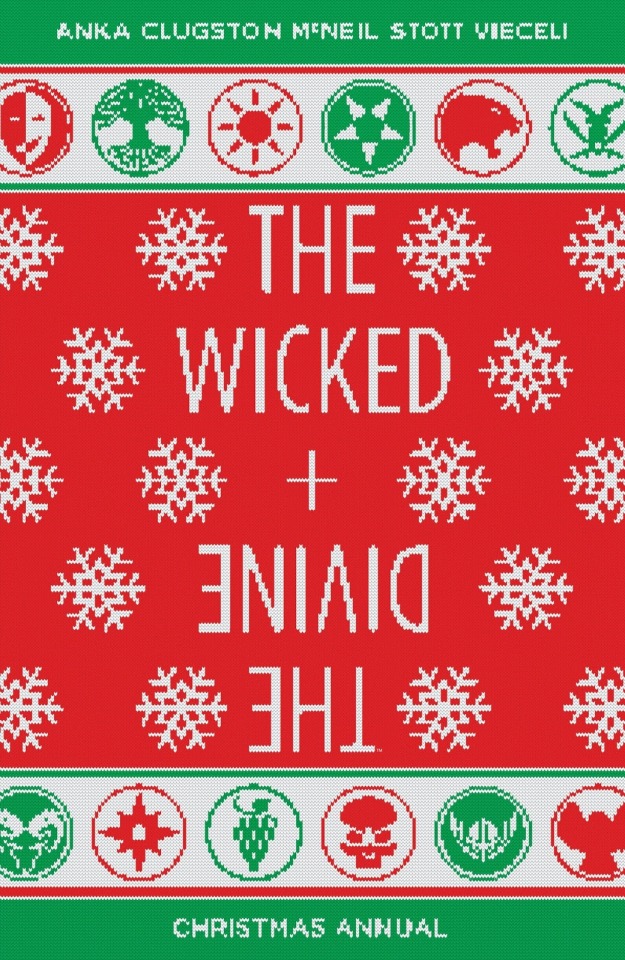
STOCKINGS
What kind of dedication does it take to spend the time you’re free from drawing a monthly comic book to actually knit a stocking cover? Jamie McKelvie, you are indeed Father Christmas.
I love the way the cover speaks to what this issue is, too – a series of little Christmas gifts from Kieron, Jamie and their Super Friends. Things we maybe hadn’t asked for (mostly) but in retrospect are so glad to have.
The Christmas Relationship Vignette format also seems a fabulously dark and twisty riff on Noted British Christmas Relationship Vignette Extravaganza Love Actually. Which makes the special a whole other level of stocking gift, because if there is one thing I would not have expected from WicDiv and yet am filled with joy and tra la la to receive it is the WicDiv Love Actually.
And true to that reference, in a sense all of the stories are about characters trying to give some version of the gift of love: pleasure, freedom, connection, safety, empowerment, or even just a lift.
(Am I working too hard to say that the Cam/Umar story, in which Umar gives a non-stop punning Cam a ride, is itself a pun on what is to be found in pretty much every other vignette? God I hope not, because that is Next Level Punning.)
In Richard Curtis’ film almost all those vignettes work out for the best. (I cry every time Colin Firth starts proposing in bad Portuguese, and every time Sam runs through the airport, and every time all the strangers start hugging one another at the end. Also I am crying now.)
Meanwhile the WicDiv version is more like, What if you already knew the ending of Emma Thompson’s story when you started reading this, and also you knew that Alan Rickman was going to die too soon and Andrew Lincoln would be trapped for the rest of his life playing a zombie-fighting sheriff in Atlanta. If you took them on their own without further information, many of the stories would be straight up sweet – Baal and Inanna, Luci and Laura and Cam and Umar in particular. If not for that last panel the Ananke/Tara story on its own would also be pretty beautiful.
(Not only is it this for-some-still-unexplained-reason-masked grandmother figure helping her granddaughter to trust her instincts and be brave, it is capped by her giving the young woman a mask of her own. Seriously, it’s a really sweet story, you guys.)

Also, there’s unbelievably beautiful pages like this one from Chynna Clugston Flores, Ludwig Olimba, Brandon Daniels and Tamra Bonvillain.
But the backstory and soon-to-be stories we know cast such shadows. Cam warning Umar he’s going to be deeply disappointed if he thinks you can trust people; Ananke leading Tara to suicide; Luci having tried to save Hazel from doom giving that same look that we have reading this, seeing her entire terrible future already in that moment of ascent.

Another gorgeous and painful page, this one from Carla Speed McNeil, Fernando Argüello and Bonvillain.
And the depths of those shadows only grow when you reread this issue again as the series continues. At this point we still don’t know what it is that Baal’s been doing to stave off the Great Darkness. But we do know that whatever it involves something he looks to that is far away, much as in this shot.

Up on the rooftop reindeer pause, because here comes The Guy Killing Children.
And his comment “Life’s hard. You have to be harder” means something so completely different knowing what makes it all so hard. And so much worse, too.
LOOSE THREADS
While this is an issue of vignettes, Baal and Luci seem almost like the main characters. They each get a strong through line. Baal’s story takes us from real human connection to crazy jealousy to weird awkward rebound and confusion. Meanwhile Luci’s story is a bit of a bittersweet Christmas Carol – she starts at peak selfishness, but then, after Laura offers her that playful moment of connection – the actual significance of which we see in Luci’s face after she thinks she’s been rejected –
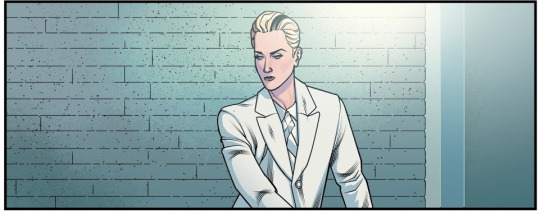
-- we get Luci’s tale of generosity, as Luci again seems to act selfishly, but this time as a a means of trying to protect her friend from this doomed nightmare she’s now trapped in. And it totally fails, which is sort of like if Scrooge changed his ways and helped the Cratchits and Tiny Tim grew up to be a miserable bastard.
Chronologically Luci’s a bit of a twisted tale; the middle vignette actually occurs last. But resorting the elements seems to make things only more brutal; Hazel and Eleanor were these great friends, but Hazel had this obsession; after her own ascension Luci tried to save Hazel from her obsession, before giving in to the selfishness of her “part”. But at the height of that her friend returns, having missed the point entirely and taken on her own terrible doom-laden role.
And now rather than an effervescent moment of sexy Laura’s flirtation is almost like a last meal. Luci’s doom is coming.
Laura is also a bridge between the two main stories, with a micro-but-not-really arc of her own: she offers herself to Luci entirely in the moment and joyful, ends up with Baal, which should be similarly All Systems Awesome, but then he slowly melts down into that classic multiple partners house of mirrors of insecurity.
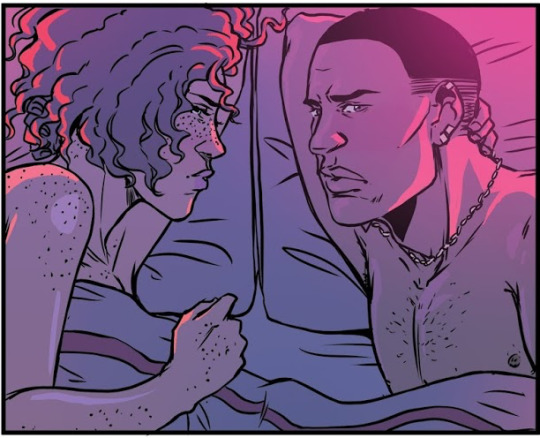
God I love this image; Baal facing Laura and yet still looking away captures so much about him.
And with that comes new insight for Laura, the painful depths of which she will not begin to understand yet for quite some time. But artists Emma Vieceli, Dee Cunnifffe and Matt Wilson still nod to it, ending on Laura smoking, the quintessential Persephone-is-in-Hell image.

(This story also has one of the great titles in the history of great WicDiv titles, “Uh-Huh-Huh.”)
Another one of those great WicDiv issues that only grows better the more times I read it. And like every great Christmas song, it only grows sadder as well.
#wicdiv#kieron gillen#jamie mckelvie#carla speed mcneil#chynna clugston flores#shag dual carriageway#to me you are perfect for now
16 notes
·
View notes
Text
THE WICKED + THE DIVINE #33: YOUR DERIVATIVE SHIT (AKA TWIST AND SHOUT)
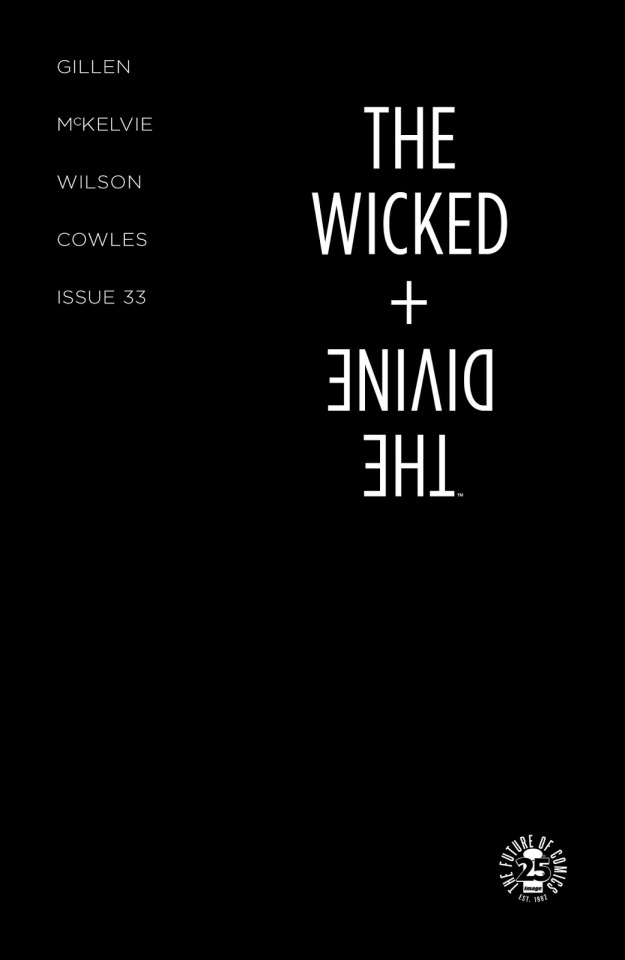
This cover. Black to me signals death, or something awful. And I was certain that we get all-black pages somewhat regularly in WicDiv, but you know, it’s not true. Both when Luci gets “killed” and Laura herself “dies”, we get pages that are black but for two tiny almost exactly duplicated comments.

The Underworld is obviously a land of darkness, and there are two moments – during Laura’s first trip down there and then when Persephone first gets her hands on Woden – where we get a splash page of endless black into which the character is falling.
But the only time in WicDiv that we’re given a non-dialogue-y black page is when Sakhmet takes out her dad in issue 17, and again in issue 28 when she massacres her party people after coming to believe they’re all laughing at her. That last one does give one tiny little glimpse of her, though.
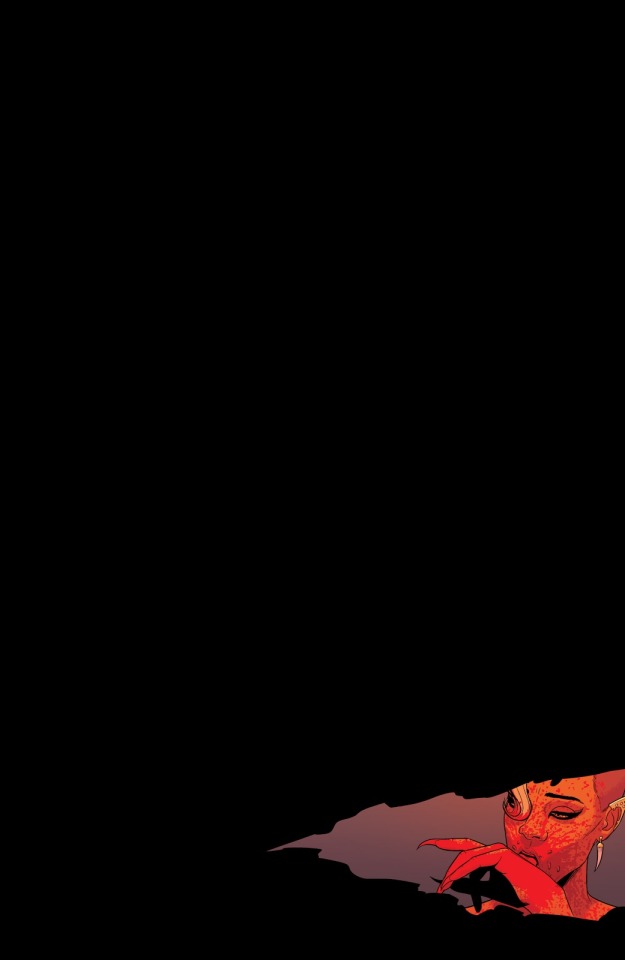
So if there is a “language” to the all-blacks (non haka version) (love you Kiwis), it would seem to be something to do with violence and lost time.
But we’ve already done all the blood and nightmares in this arc, and this issue is instead filled with twists and reveals and honest soul-rending conversation and reunions and new friends and overall kind of a lot of reader satisfaction. So a very different thing.
Another take on the all-black is this is what you put on your cover when you’re terrified anything else will give something away. But for as much anxiety as Kieron talks about in his notes about “keeping the secrets” of this issue (and also his sense of what nonsense that fear is), he and Jamie have never had any trouble obscuring reveals before.
So here’s my thought: Maybe it’s like Disneyland. Disney theme parks are built in such a way that on the way in you have to go through a tunnel of some kind, and before you do you can’t really see inside to all the happy happy joy joy good stuff.
The idea is, Disney wants you to feel like you’re entering into a whole different world than the one you left behind, a better world where you can be happy and spend money and want to take the same picture in front of the castle that everyone else does and still feel like it’s special. And part of that is creating a clear sense of boundary; there was where you were and there’s where you’re going, and the tunnel stands as passage in between.
Maybe that’s why you do a black cover: Not to hide anything or signal violence but to create a boundary, a sense of a passage into something new.
PHALLUCIES
So we begin with the Vibrator as key. I want to say it might be the perfect Gillen/McKelvie image – it’s naughty and seems like a joke and has been sitting there for so long that we no longer think much of it when in fact it is absolutely essential.
Nothing in WicDiv is superfluous, minor or irrelevant. Everything is trying to express something important. (TELL US ABOUT THE VEILS KIERON.)
A bigger question: does the fact that Jon (and not only Jon but the truth about Laura) is released into the story via a phallic device that vibrates have even more to say? Is pleasure or self-care in a sense the key in WicDiv, a path to freedom and life?
Have I not mentioned already I was an English major?
READ ONLY MIMIRY (#SorryNotSorry)
After an arc that seems very caught up in how the characters are all caught up in/pinned down by stories, suddenly out of nowhere we have Jon, this breath of fresh air who sees that path for the garbage it is and refuses it. He will not fit the options Ananke poses, or any duality, thanks very much.

He is the one who builds.
Of course he is then force-wrapped into stories – the Pantheon (I love the horror of his reaction to his ascent), this weird Odin/Thor thing (complete with the nod to Thor’s alter ego Donald Blake) and also the biblical Abraham and Isaac story, the father sacrificing his son to God (now comes with beheading!).
And if I understand the father/son dynamic, as much as Jon sees the Mimir thing for the lie or trap it is, he still can’t quite help himself from being a builder. There are rules he can bend (see: vibrator) but he can’t quite enact a full break.
His call is really quite beautiful. “You walked among your foes for the sake of love,” the spooky Ananke heads say. “Struck down you are raised up, the Sky King’s grandest treasure.” It’s pretty much the absolute opposite of his Dad’s call.
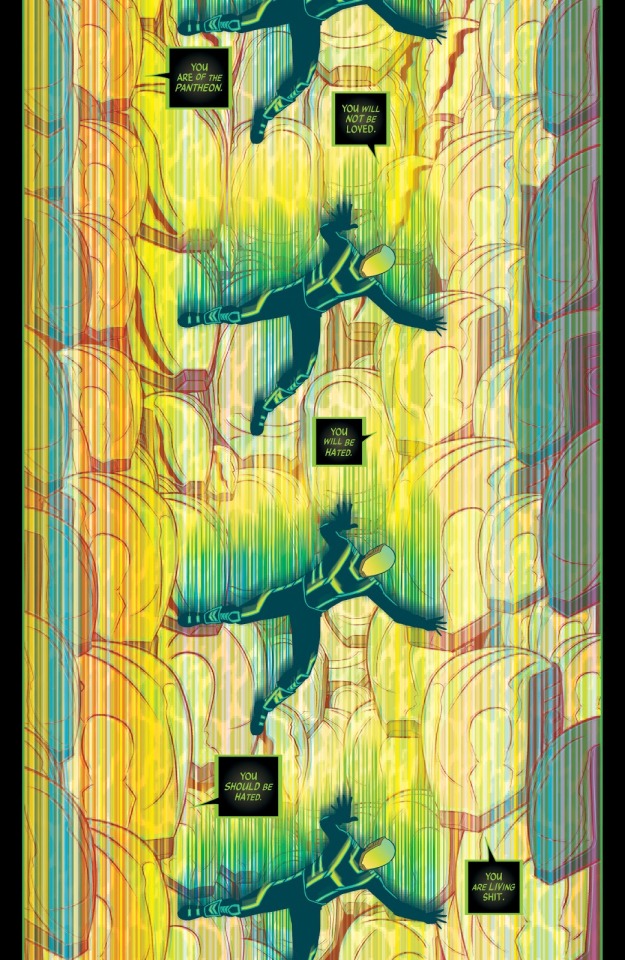
How crazy is it that we’re 2/3rds done with the series, we’ve just been introduced to a major new character (okay we saw him once before but still), and he fits in so well?
Probably we’re being set up for betrayal and heartbreak, but for now I love it with all the loves.
MACK THAT KNIFE
Can we just talk about the knife for a second? Like, how exactly does it work? Clearly it somehow enables the user to disengage the head from the body while keeping the head alive. But whereas with Jon that might have happened literally – put your elbow into it, David! – in the case of Luci, Tara and Inanna Ananke used her signature head pop. So what’s the deal? It’s enough to have the knife in your possession when doing with the murdering, or something else?
Also, post-beheading, we see Ananke referring to Jon as “it”.

Is this because he’s now “just” a living head? Or is this how she actually honestly sees all the gods? It’s um, upsetting to say the least.
Of course so is Woden’s take on things: Jon stole my life (by being born, you horrible human looking meat puppet), so now I get to steal his.
I don’t know how it would have been possible Woden could sink lower in my estimation than he has (#Dio4Vr), but in fact it is and he has.
CASSANDRA VS. THE DESTROYER ROUND II
As much as I love the Jon reveal, the thing that really rocked my world was actually not that but Laura explaining what she’s been going through. I just – this poor girl. And though we still have two arcs to go, in a way this moment is the heart of the series. Kieron seems to say as much in the notes, talking about how the artist lives in this awful reality of getting what they dreamed of, but it involves awful stuff happening to oneself and others.
“I’ve talked about having mixed feelings about WicDiv’s success. Laura’s arc is it writ large. I hate that the definitive work of my career is this. If my Dad was not dead I would not have written this book. There is a guilt and anger that is hard to articulate directly there, and is the material I was mining for this.”
Art is built on suffering and loss—and that means on the back of horror done to others. To wish to be an artist is in a sense to sacrifice those relationships in a fundamental and sometimes literal way, in fact that seems a necessity to one’s success. Being a storyteller may be incredibly nourishing for others, but it’s built on harm done to those you love.
Jesus Christ this is dark. And we haven’t even gotten to the point yet of facing the question that society’s survival is supposedly built on those artists’, those children’s destruction. We love you so much, you inspire us, but what cements that for the century is your deaths.
What do you make of this follow-up moment where Laura suddenly turns it to 11 with Cass?

It only happens after Cassandra calls Laura Persephone for the first time, which seems like it’s meant as a kind of respect. Knowing what she’s been through, she is now worthy of her name in Cassandra’s eyes. She is an equal.
Except it seems to set Laura on the path of what – connection, for sure. But through sex, which is actually more escape than intimacy.
What is “The Destroyer”, in the end? Less a malevolence associated with Laura, it seems to me, than the character of all the gods when they get lost in their stories about themselves.
(More to the point: What the heck is the Machine? Jon says it does nothing. Whuhhh?)
A STEP A HEAD/STOP MAKING SENSE
So, after quite some issues away from it, in the end we return to the heads. Lots and lots of heads. Jon’s head (god that’s a delightful reveal), then Sakhmet’s slice of head – and Minerva – and then finally, the big finish.
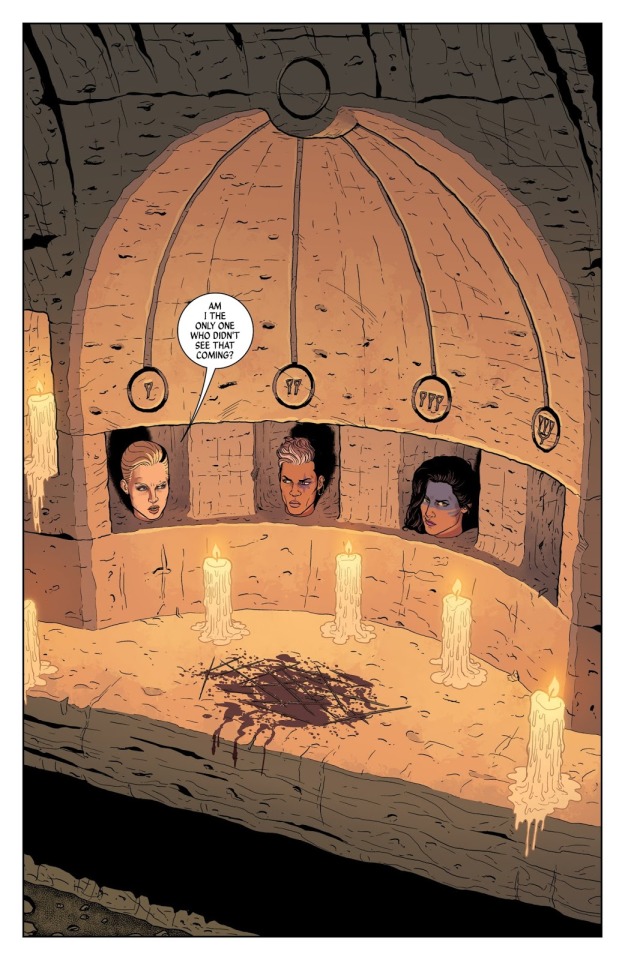
I would say my head exploded except I feel like that gag has already been played.
As he has mentioned often in his notes, Kieron loves to hide much bigger reveals within the reveal we know that’s coming. In this case, we knew there was this other Daft Punk member hiding in the darkness somewhere, and we knew there was something up with Laura we needed to hear about.
So we get that and say thank you, and then there’s still four incredible jaw dropping can we please do a happy dance for Luci pages.
Kieron goes into a ton more detail on this writing strategy here, and the particular nightmare challenges posed by this issue. I’ll post excerpts below, but you should read them in full. They are fantastic.
But if I can just ask one question: What the hell happened with Minerva? Am I to believe she did not feel bad about Sakhmet, that she’s that good an actor? Je refuse! And also isn’t the point of the Sakhead reveal that still-Minerva blew it with her fearfulness and lack of skill?
#CRAFTSERVICE: ON TWISTS
Okay… twists.
In reality, for me, it’s a case of once you’ve decided that this is the plot, the only way to do it is dovetail towards an issue like this. Any of these individual beats provide too much connective tissue to the other ones, meaning all must be revealed or none.
(You could argue about Minerva, I suspect. Maybe.)
It’s been strange writing a book like this – when so much is there early on. Seeing who got what and who didn’t, and how people reinforced people has been interesting. That the core WicDiv tumblr community has never really suspected Minerva was off is in some way a surprise – though I’ve had people talk about that directly and personally. Blake/Jon and Minerva-is-Off-In-Some-Way were the two twists I would guard, but their primary importance was in how they led to the Heads.
When Ray Fawkes told me “There’s a reason you’re doing all the decapitations, right?” circa issue 2, I suspected that I’d overplayed the hand by having a literal talking head in issue 3… but it turned out fine.
“Played the hand” is interesting phrasing, and telling. Writing something as intricate as this is like doing a slow-motion card trick, in public, constantly. It is a form of constant stress. I have been paranoid of fucking it up in stupid ways, and it’s impacted every single conversation I’ve ever had about WicDiv. Like just writing one name when I mean another or something. There was a hilarious panic when I added ‘Killer Queen’ to the playlist, just thinking of it as a quite funny Ananke song… and then realised there was only one character in the cast with a connection to the band Queen, and that was Minerva. Should I take it off the playlist? No, someone may notice that, and it’s against my rules anyway. I quickly added a few other things to camouflage it.
As if anyone is watching that closely, y'know?
That’s an extreme example, but an entirely characteristic one. I have lost sleep over it. Even a year ago, I wished I could just get to 33 and not worry about it. When 33 dropped, it was simultaneously excellent (the response was basically what we expected) and an anticlimax (The amount of emotional and intellectual effort you put into doing this is not worth it. It could never be worth it.) I’ve been telling friends that I’ll never write a story that operates like this again. Partially that is because I wouldn’t want to repeat myself, and partially because – as I said above – I think twists are less effective in long-form serialised work in 2017, but mainly as I don’t think I want to do this to myself again. I’ll find some other way to torture myself.
So apparently Mini has been off all this time. I’m stunned by that.
#CRAFTSERVICE: MORE ON TWISTS!
I’d note that setting up twists that *are* easily guessable by the hardcore is part of the methodology. Having a nice big twist foreshadowed heavily is a good way to hide another twist behind it. “Hey – pay attention to this less subtle sleight of hand while I perform the actual sleight of hand over here.”
Oh you’re expecting a big reveal are you, cool cool cool here it is and also SURPRISE.
He talks about this again later, in response to the reveal that Mimir is just a talking head.
When thinking of plot structure, I talk about a few ways to disguise twists. Earlier, I mentioned a Big Twist can make people suspect the twists are over. This is something I tend to think of as a revealed move. As in, you create a machine of logic with a missing part. You add the missing part as late as possible, and then immediately move to what has been concealed before the audience is able to process the new information.
Oh you’re blown away by Mimir are you? SURPRISE, there are three other heads. And also Minerva is not Minerva.
It’s a great insight, too – if you fear one bit of new information is going to naturally lead to others, drop it all right now before they even have time to think about it.
#CRAFTSERVICE: ON WHAT WRITING IS FOR
I know this is a lot of quoting the author, but hey it’s a big issue and the author has some great stuff to say and it is helping me.
How do I actually feel when someone guesses something that’s going to happen? Well, this is long enough already. Let’s put the personal stuff beneath a cut…
I’d say you sigh “Oh, poop” and shrug.
And then you get over your ass, because you know all the above is true. Writers are often megalomaniacs who think they can control everyone’s response to their work. We don’t. We can’t control everything. We can barely control anything. We really have to let go. I’ve said WicDiv is a device to help me improve as a person, yes? It would include in this area. I have to learn to let it go, and internalise all of the above. If I can make most of my readership have the vague emotional response I’m looking for, I’m winning.
Certainly I’ve heard many writers talk about their writing as coming from a personal place. And as a writer myself I’ve had to learn (again and again) that having a sparkly fun idea is not going to be enough to get me up and writing every day, even if people like it. That I need what I’m writing to come from something more specific in me.
But I don’t know that I’ve ever heard an artist talk about their work as well, their work. The journey they’re taking to try and deal with something or figure something out or to let go and get free and be a better version of them. It makes so much sense, and man does it challenge me to have another think about my own work. Because I think most of the time I almost think of the journey as the thing that has to come before the work, the thing that prevents the work – Ima just get my act together and then write this script in fifteen years or so. And reading this it strikes me oh wait, that’s just the thing I tell myself so I don’t have to do the work.
There’s so much more to say about this issue. But it’s taken me the better part of a week to say this much already so maybe I’ll just leave it there. Suffice to say, it’s a giant of story.
(And yes, that’s my exhausted end of words attempt at a Mimir pun.)
I’ll be back next week with the two specials. And then, Mothering Invention!
4 notes
·
View notes
Text
THE WICKED + THE DIVINE #32: ARTISTIC SACRIFICES

Sigh.
JUST ANOTHER LOVE STORY
Once again we return to Laura lying on her bed smoking, when Sakhmet shows up to say something matter of fact. You know, like she murdered Amaterasu. Just another day in the life.
What follows between them is an unexpectedly intimate scene, as they lie in bed and Sakhmet asks Laura about the things she shared with her previously. It’s an incredibly dangerous moment for Laura, the kind of moment any of us would try to fill with as many plausible lies as we can. But Laura is instead completely straight about having betrayed her.
In retrospect, fom a strategic point of view that is actually probably the only survivable choice, as it’s the one move that does not put Sakhmet in the position of the fool.

NEVER PUT BABY IN THE CORNER OR SAKHMET IN THE POSITION OF THE FOOL.
But if Laura has any strategy, I find myself wondering if it isn’t once again, What’s the thing I can do that can put me out of my misery once and for all? Kill me now, please.
There’s also, What’s the choice that respects our relationship? There’s something strangely loving in Laura’s honesty, and an unexpected care in Sakhmet as well. Rather than her typical predator/prey stuff (see: what follows), here she actually seems to breaking her own script, asking real questions, lying in bed with her lover, you know, loving. Could it be that Laura is the one person that Sakhmet actually loved?
Laura’s explanation for her choices is interesting, too.


Given what we’ll learn next issue, how she’s blamed herself for her family’s death, is this how Laura has understood herself this last arc, as someone who has had to lock herself away because she hurts people?
DIO-LOGUING

After Dionysus awakens to find Woden has ripped off his whole thing, we actually get an internal monologue from him. First inspiring, then devastating internal monologue.
I’m pretty sure Dio is only the third person we’ve ever gotten to hear from in this way, after Laura and, actually, Woden. (I’m surprised we haven’t heard from Cassandra, too. To me she’s second only to Laura as our POV character.)
It would be interesting to think about why we’ve been granted such special access to these characters and not the others.
Actually, let’s step back and think about that... In a sense Tara’s unsent letter to her fans in issue 13 was a way of accomplishing the same thing, and the upcoming Christmas issue will actually see her deliver internal monologue.
We can’t get internal monologue from Baal and Mini because their secrets are too important.The Morrigan is too lost at this point. Sakhmet’s lack of an internal monologue is a fundamental part of her character; it’s her silences that tell us everything. Similarly, Inanna’s gift really is transparency. What he says is who he is, what he believes. An internal monologue would be redundant.
Ammy can’t have an internal monologue because she’s way too invested in being a god to allow herself to check in with her authentic, so broken self. And that makes for an interesting comparison with Cassandra, who clearly has an internal life, but her superego is so freaking strong it drowns everything else out. If we ever going to hear from her, I wonder if it wasn’t going to be during Dio’s test rave. But I hold out hope.
Baphomet couldn’t have an internal monologue before now without probably ruining the reveal of what happened to him, what he’s been through. (Though we did have moments early on where he was talking to a disembodied head version of himself. Always with the severed heads...) But he’s grown so much over the course of the series, both personally in our eyes, I think I sort of hope at some point we’ll hear from him.
And Luci...? Well, she’s only around one arc before she gets got. In some ways the Christmas issue is her internal monologue, with her comments to both the fanboy reporters and the newly-ascended Ammy telling us what’s going on inside her. But here again, I’m hoping post-33 that we might actually get something more.
ANNNNDD....SCENE

Dio’s journey through the first half of the issue follows the visual structure of his hivemind rave, each image paired with a number counting the beat. But now that idea has been (brilliantly) (devastatingly) folded into the Pantheon idea of the 4 beat countdown to death.
And even before Dio falls into his coma, the final image on each of the 4 pages laid out like this--even the number of pages part of the countdown-- foreshadow his doom. He loses touch with his powers at the end of three of the four, and in the fourth (the second page) he admits it’s getting hard to breathe.
Once more, sigh.
I love that Dio’s ending is, as repeatedly warned, all tied up in his desire to help. His self-belief is a form of pride, I guess, but I don’t think of him in those terms. He’s the guy who thinks being a god is about leaving it “all out on the field”, giving everything for others. And that’s not so much arrogant as it is beautiful and foolish. One of the most awful (devastating) (I really hate what happens to Dio, you guys) realizations of this issue is the fact that his sacrifice is not only a failure but that it’s completely unnecessary. The Norns wake up and shut this whole thing down immediately after he drops. I mean literally the same page, three panels later.

(God I love the Norns’ spider-web eye thing.)
In a way Dio ends up very much like The Morrigan; rather than embracing the truth of himself he’s made himself a character in a story, The Savior, and even though that seems like a much better choice than Selfish Shakespeare Goth Lady, in the end it’s just as ruinous.
THE MADDENING CROWD
I don’t know which is worse, Dio dying for nothing or the fact that the crowd that he invited to this amazing experience in the end are just as happy with Woden’s Shithead Hack of their Lives as Dio’s Life-Affirming Rave.

Actually never mind, this is worse, as it means not only did Dio not need to save everyone but they are ultimately not interested in being saved by what he’s been doing. They just want an experience. Humanity, why are you/we?
MOMENTS OF (UN)TRUTH
Cutting back to the Pantheon v. Sakhmet Underground Fight, we get first the truth about Laura: As much as she fashions herself Destroyer, in the end she just won’t pull/snap the trigger.

Then from out of nowhere we get Mini’s moment of truth, which marries Sakhmet’s particular form of Nihilism to Baal’s.

Buried in the background of Laura’s journey there has been an ongoing somewhat parallel story about Mini. She’s the sweet kid that’s so good-intentioned when she almost kills Brunhilde she can’t leave her bedside.
Then in the face of Ananke and her parents and the Great Destroyer she’s pushed to consider another way, in fact not just another way but the very way that her parents were killed in front of her. And finally, she has given in to it.
She Has Done What She Had to Do. She Has Chosen Predator. She has Become Ananke.
(Or has she? When did that happen? Still so confused about that.)
CASSANDRA VS. THE DESTROYER: ROUND ONE
The Norns see through Woden’s “derivative shit”. Of course, they don’t ask derivative of what? Still, it’s a deeply satisfying moment.
And so is the wisdom this whole experience seems to bring Cassandra.

Even as she’s spent so much of the series trying to understand everything, her fatal flaw is some combination of the fact that she actually thinks that’s possible and most of the time she thinks she’s already done it. In a sense Imperial Phase has been a slow descent into humility for Cassandra, with Dio’s test rave, Cass visiting David’s house, the Norns just now being so easily betrayed, everything to do with the machine and then next issue finally learning the truths about Woden and Laura each a step along the way to real insight – and humanity. That scene of her comforting Laura next issue is such a beauty.
Here of course, even after being fooled so very badly she’s still not quite there yet, and she has for Laura nothing but condemnation.

Which of course has got to be very much the voice of some of the audience too at this point. I mean Jesus Christ, Laura, you chased this so hard despite everything saying this is not what you think it is and then it cost you so much and still all you can do is wander around sad?
But I love how Laura turns that back on Cassandra, and how it also draws in Dio. In Save everyone versus save no one, try to learn everything versus not even bother to try has not only not panned out for the “good guys”, it’s been proved to be destructive and foolish. It’s all the same in the end, all just b.s.
Given the arc’s through-line of characters trapped playing out roles and narratives, there should be something liberating to Laura’s take, too. Except even as she’s saying all this, she’s also mostly interpreting herself in terms of a role. She says that role is Destroyer, but actually given how much she think she knows, the doom she sees coming for all of them, really she’s the one that ought to be called Cassandra.
14 notes
·
View notes
Text
THE WICKED + THE DIVINE #31: SHI(N)THEAD GODS

Woden’s tech spreads like a virus, erasing any sense of the container used in the prior covers. It’ll dominate everything before we know it...
CROWD MECHANICS
This is the trap sprung, with the reasons why still to come. It’s been set up in so many ways, from Woden using a prior rave to finally “get” the Norns and then in the last issue talking about how he can shut down people’s powers if necessary, to his goal here of mapping and controlling Dionysus’ hive mind, which he also mentioned last issue was something he had not quite learned to do yet.
Here and throughout the issue we’re also given these great studies in contrast. Dionysus as a god who helps people experience a sense of beautiful fun shared experience in which they are each allowed to be themselves (that splash page where everyone has their own color is gorgeous); Woden as one who wants to coopt everyone into a mob whose identity is not only uniform but uniformly him.
It’s two different versions of a communal experience, one joy and one nightmare. And it’s brilliant that it’s written as the one shifting so easily into the other; once you’re a big crowd, the difference between rave and mob is ever so slight.
Also, we’re agreed they both love Cassandra, yeah?
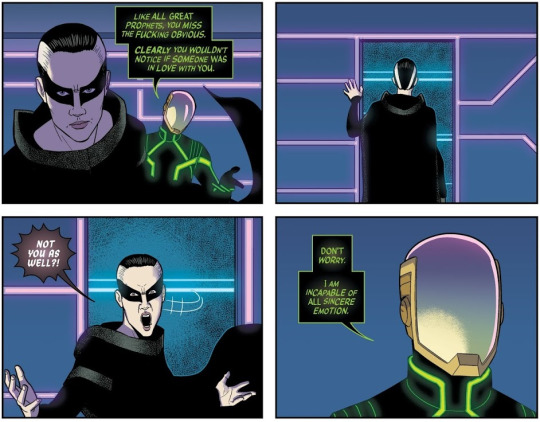
MISTER CLEAN
Cassandra and Dio’s conversation about honesty in relationship continues the Morrigan’s comments to Laura at the end of the prior issue.

Baphomet’s truth-telling was self-serving, and Dio refuses to be honest with Cassandra out of the same concern. But notably, for Dio too it really is about being clean or pure of heart.

Also, this very same noble-self-sacrifice-because-heroes attitude is the glitch in his thinking that’s going to get him killed. So basically it doesn’t matter if you’re self-serving or not, it all goes bad? Or maybe telling the truth, not telling the truth is irrelevant, they both can come from a self-serving place and everything is complicated and argh why god why.
(Random Horror Filled Aside: It was only on rereading that I noticed Dio’s actual line about doing the rave despite his exhaustion is “I can sleep when I’m dead.”
Cut to: Next Issue.


Jesus Mary and Joseph Kieron.)
PAGING PHILIP LARKIN

Ammy’s real super power might be that she always knows just what to say to ruin everything. And here again, it makes for a fantastic moment of similarity and contrast. She and Sakhmet have both been so deeply, inescapably marked by their fathers, their very identities as gods molded out of those experiences, and their deaths too.

Enjoy your Shinto, girlfriend!
Jamie does such a fanastic job on the storytelling of those last few pages. There’s such a rich slow motion feel to the panel choices; you can feel Ammy slowly falling to her death.
It’s also amazing to me how much the issues with guest artists, which seemed to be about enriching the backstories of Ammy, Sakhmet, Baphomet and Morrigan, end up now central to the narrative.
In just one panel, in fact, Jamie calls fully to mind the start of issue 17, where we saw young Ruth Clarkson staring up at a statue.

But where young Ruth finds comfort in the hardness of the statue: “she’s made of stone. She doesn’t feel anything”; here the image shows instead vulnerability. You can see it in her eyes, how she’s looking for comfort.
It’s really the most exposed we’ve ever seen Sakhmet. And the most contemplative.
CIGARETTE BREAK
If you were going to capture the essence of Laura in this arc, you could do a lot worse than this:

She spends much of the arc in bed; in this issue and the next, we’re actually given exactly the same set of three panels.
And what is it she’s thinking and doing here? Waiting for it all to end? Trying to formulate a plan? There’s a sense of uncertainty, inertia and also doom that colors the whole arc. Laura stands (lays) outside the horrors happening, observing, waiting, desperately trying to give up.
I wonder if she finds herself thinking of Luci at these moments, bittersweet at what her journey to be like Luci has cost her or wondering whether this is how she felt. As much as she’s in pain, there is something of a child playacting like her cool older sister/babysitter.
21 notes
·
View notes
Text
THE WICKED + THE DIVINE #30: DIONYSUS IN DARKNESS WAITS
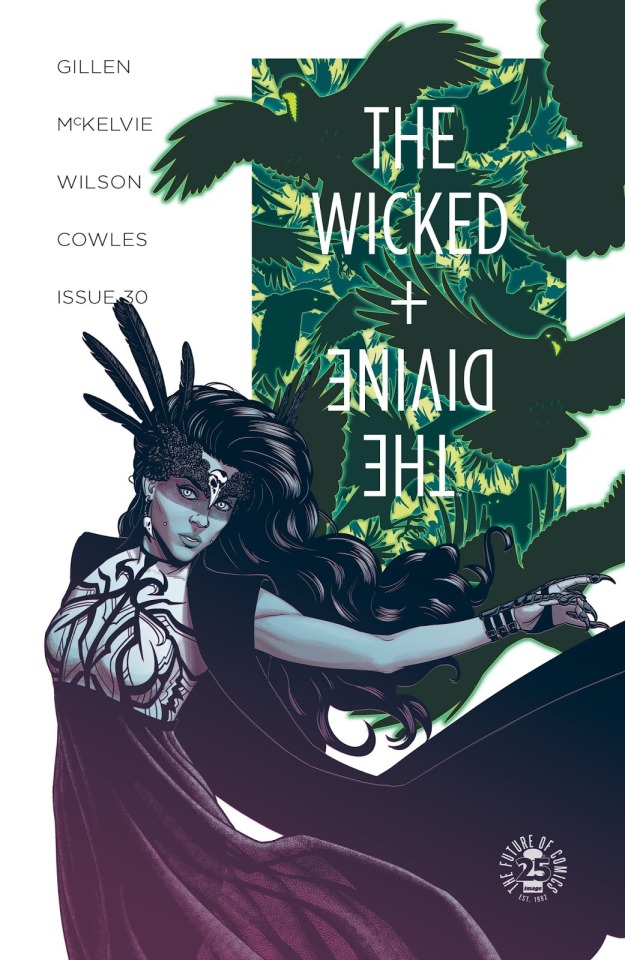
The thing I find interesting about this cover in conjunction with last issue’s is how once again the “power” of the god is bursting forth from the box it’s in. Each issue in this arc takes that idea further, signaling perhaps the deepening chaos that can’t be withheld. Just the glimpse within the box here, the number of crows, has a kind of insanity to it.
#CRAFTSERVICE
Kieron’s notes are always well worth reading, but the notes for this issue are particularly fantastic. There’s this great reflection on the history and strengths of the second versus first page reveals:
“I’m always interested in the history of the second page reveal. Old school comic writer guides normally suggest opening with the big image, to throw people in the world. That – and, I feel, especially in the 00s – got changed into the delayed reveal. Enter the world in a quieter way, and then do the big reveal. That means you can create some context quickly, and use that big impact for something a little more complicated.
(It also means if you go to a 2-3 page splash, you can make the image bigger. If I remember correctly, almost all the New 52 books hand that rhythm, which I have to presume was an editorial guideline. I may be misremembering though.)
It’s worth noting I say “a little more complicated.” I don’t say “sophisticated” or even talk about effectiveness – complicated says nothing about a piece of work’s quality. I just mean there’s more moving parts involved before the reveal. Look at someone like BKV and his love of the opening splash to see how effective the HELLO, HERE I AM, LOOK AT THIS THING! Can be.”
There’s also a great reflection on the fairy tale-like structure of Dionysus in the underworld, the three beats in which a situation is established (”I’m hungry, I guess I should break into someone’s house and eat the already-prepared oatmeal on the table and not wonder how that’s here or whether I missed the Rapture”); the problem of the situation is repeated a second time (“And this oatmeal has too much lemon zest!”) and then finally in a third beat the set up we now expect is subverted, creating resolution (Bears enter, Goldiocks smiles; Cut to: Goldilocks eating three steaks. “Now these taste just right!” Annnd...scene.)
Dionysus faces three challenges – Sympathy: You mean well but you don’t understand; Threat: Imma kill you if you stay; and Truth: You’re going to die soon.)
(Actually it’s very much Christ’s temptations in the Desert, isn’t it, complete with all three temptations actually coming from the same person and the context being darkness and oh God how am I just realizing this now someone please take away my Catholic card stat.)
I love that the third challenge, the hardest comes in the form of the sweet truths of Annie. You think you can save everyone, you can’t and you’re going to die.
That three beat pattern, Kieron notes, is also the pattern used in comedy, which also seems fitting given that we’re dealing with Baphomet, the Pantheon’s Dad Jokester.
THE NEVERENDING STORY
Post-455AD the use of a fairy tale structure makes me think once again of how these characters are trapped within stories. The Morrigan also says as much:

Having said that, even if Dio is in a sense just playing the role of Messiah (hey, don’t those guys usually get betrayed?), I love that the form that takes here is just him sitting here taking whatever suffering The Morrigan dishes out and waiting for his friend. A beautiful encapsulation of the blessing that is Dio.
WODEN GRAMS
Unlike 29, 30 has lots and lots of Woden in it. And now some clear indications of how he’s been playing them.

The little prankster. But played for laughs, the moment doesn’t really alert us to just how much trouble we’re all in. This is basically just what you’d expect from Woden. Garbage gotta garbage.
The one real warning sign is hidden amongst the Instagram images.

Look at that post. “Gig of the Saeculum prep. Dio vs Woden vs Norns, live now, dead soon.” Of course he can post the truth on Instagram: Cassandra would never see Instagram as a forum worth being on (catch her on Twitter), and Dio is too busy to pay any attention.
God he’s awful.
WAIT NOW
The two pages of people checking feeds also includes one panel that is not like the others.

Who is suddenly talking here? It’s the same font and design used when Laura spoke to us at the start of 29, so it’s got to be her, right?
But Laura hasn’t even appeared in the issue -- and won’t until the end, when she rescues Morrigan from Sakhmet. So what does it mean? And why is it here?
DOOM WHERE YOU ARE PLANTED
The Baphomet/Dio exchange once again has three beats – first Baph trying to be all whaddup bro and talk down what Morrigan’s done; then a glimpse of what he went through which absolutely changes (and explains) our entire experience of Baphomet -- and particularly his behavior in the first couple arcs.
(Random aside of total admiration: Think about Baph’s arc. When we first really meet him in issue 3, his interaction with the Morrigan is so in medias res it’s hard to know what is going on.

In retrospect that experience perfectly captures the hot mess that is their relationship; Baph and Morrigan are that couple so lost in each other it’s impossible for anyone else to really follow what they’re on about.
But in the moment Baph definitely seems also like White Male Pig, an intrepretation Kieron will make a meal of for issues to come. In issue #30 we finally get the explanation of what that was really all about, and it’s so much more. Baph is being so awful here because Marian has just before this utterly betrayed him, literally doomed him.
Actually, him responding to that by acting the male pig almost seems like he’s cutting her a break, presenting himself as the real bad guy, when it’s so totally her.)
Then in the last beat we get Dio trying to talk Baphomet into facing what happened, trying to free him really, and Baph deflecting by pointing out Dio’s own imprisonment, in love with someone who can’t love him. (The Dio/Cass/Woden love triangle really is such a great thread of this arc.)
But it’s interesting how that also creates for Baph a sense of connection and community.

Much like how Laura will describe her relationship with Sakhmet later in this arc, and how Baph’s relationship with Morrigan clearly works, doom offers the Pantheon the strange flipside of comfort. I am not alone in this impending destruction. You are here with me.
Yeah, but we’re doomed. That is bad.
Yes, but we’re doomed together.
Yeah, I get that. But we are doomed.
Exactly. We.
Dude, you are such a hot mess.
And of course because this is Baph the issue ends with him having to jinx everything.

DUDE, WHAT ARE YOU TALKING ABOUT? THIS IS WICDIV. IT CAN ALWAYS GET WORSE!
yeah but not really tho because we’re together
Okay, I am so out.
#wicdiv#kieron gillen#jamie mckelvie#Baph: the Potsie Weber of the Pantheon#Whatever Happened to Anson Williams?#WHTAW
5 notes
·
View notes
Text
THE WICKED + THE DIVINE #29: WHAT IF THANOS JUST WANTED TO KILL HIMSELF?
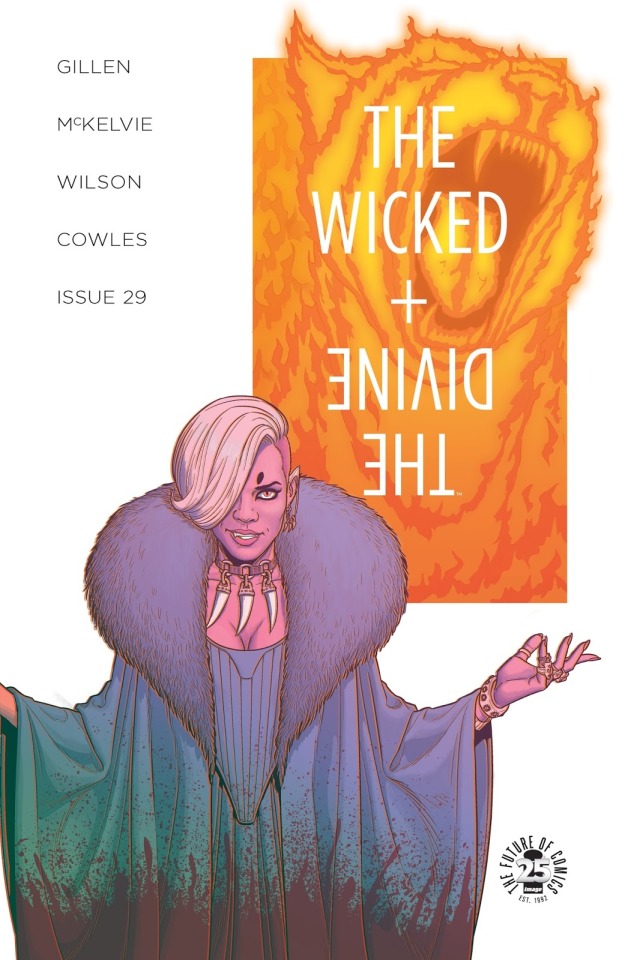
Sakhmet like a queen before her people, resplendent, except Can We Get Costumes Down Here A Second, Sakhmet’s got a little bit of Schmutz on her Gown.
UH HUH

It’s just one panel, but for the first time since her “death”, Laura speaks to us.
Though that’s as internal as we get, much of this issue ends up more or less from her point of view. We get Baal’s first performance and Sakhmet’s – which turn out to be a memory of Laura’s, followed later by an early a memory of hers with Sakhmet, her reflecting aloud with Cass about the nature of her relationship with Sakhmet. Then we follow her through an evening of unwelcome Pity Partying.

(I don’t know that I ever fully appreciated the presumption of tweeting a condolence at someone you don’t know. Wow is it awful.)
In the midst of all this we get the clearest sense of what Laura has been up to with Sakhmet, a combination of self-destruction – “It was like having an angel of death as a girlfriend” (yikes) and the search for if not understanding, connection -- “We got to be doomed together”.
(How many relationships could be described that way, I wonder, when you get right down to it? 'I feel trapped and being with someone else who felt the same made that temporarily more bearable.’)
I found myself wondering at some point what is with the issue of doubles – Laura trying to numb/erase herself with Fauxciver, Baal breaking in on Sakhnot? For me, it has the slightly sour air of decadence of a band just a hair past its prime. Instead of inspiring people or the gods to new things, there’s that sense of returning to old i.e. tired paradigms. It’s akin to Lucifer in 455 AD, the characters trapped, and Persephone similarly trying to escape, but doing so once again not by walking away and breaking the cycle, but by trying to get wasted on sad, derivative forms.
GOD GAMES
For as much as the issue centers on and around Persephone, in the background we’ve got every god but Baphomet active in a worrisome way.
Ammy, having once again fled the scene, plays dumb about what happened. That’s definitely going to end well. Meanwhile Baal not only embraces Ananke’s Snap Crackle Head Pop, but insists Minerva learn it. That’s definitely going to end well.
Elsewhere, The Morrigan admits yeah, Baphomet didn’t know what he was in for. That’s definitely going to end well. But she also notes that Cassandra did the same thing – which I would not have wanted to believe (#TeamNorns) except it’s followed by Cassandra explaining herself to her Norns.

We don’t get a reaction or comment from them. Based on everything else, I’m sure that’ll end well. Just like Dio deciding to go full Buddha-Jesus savior or Woden, who appears in just one panel in the whole issue, making an offer to help out. Guys, he’s learned his lesson, he’s a helper, if you need recording gear or help nullifying a god’s ability, he can help. How could that not end well?
As much of the plot of this arc is a hunt for Sakhmet, it also reminds me of a whodunit, in that right at the start we meet all the possible killers (and the one we have to be worried about brilliantly played down), but with the twist that we don’t even know there’s going to be a crime yet.
THE ARTIST CONSUMED BY THEIR WORDS
Coming on the heels of 455AD, the other thing that stands out so strongly is the way The Morrigan, too, has turned herself from person into role, complete with strangely poetic diction – “the cat cannot escape the cage in her head”, “Morrigan and my foolish king have squabbled” -- her always fabulous costuming and this idea of herself as queen of the realm.
It’s not constant; we still get glimpses of a more modern voice.
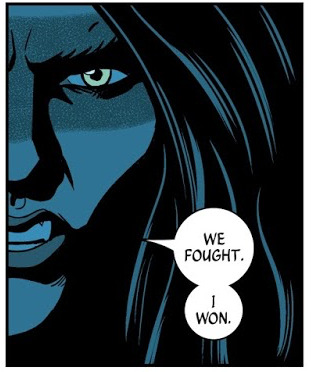
But in general Marian, too, seems more and more lost to her personas. George and Martha, sad sad sad.
13 notes
·
View notes
Text
THE WICKED + THE DIVINE 455AD: SIGH NO MORE

FULL CYCLES
We begin with a boy cutting up a lamb with a knife that looks a lot like Ananke’s, though it’s unclear at the time whether this is part of a religious sacrifice or dinner. At the end, we’ve got Ananke doing much the same to Lucifer, though instead of being the offering she’s always going on about here it’s an effort to bury the evidence, lest future iterations get any ideas.
Within the issue are so many other great riffs and repetitions; Ananke preparing to head pop Lucifer, but this time she’s beaten to the blast (and on the page turn, of course); Ananke insisting that her actions are well-intentioned – and this time to someone who you would not think she needs to convince, someone irrelevant to the endless cycle she has got herself trapped in. So once again we’re left with the thought maybe she’s...ugh....working for good? And then it’s immediately undercut by Geiseric’s doubt.
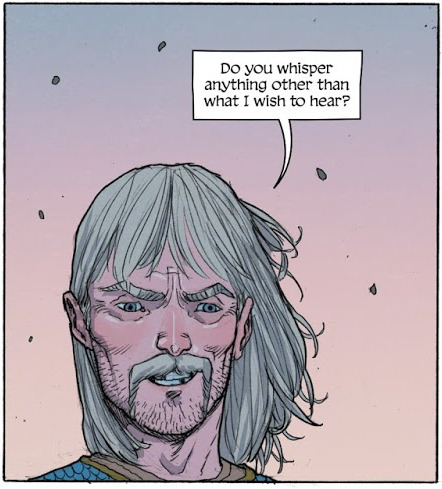
The overall plot of the issue – end of term God goes mad – is a new element we’ll also now add to our sense of the cycles going forward. In Imperial Phase I David told us this is how it all falls down, and now for the first time we get to see it happen.
(Okay, also we had Laura drowning herself in ill-advised sex and sadness and Sakhmet making a meal of the room and Amaterasu taking crazy up a notch and Cassandra refusing to just let go and let Dionysius because THE MACHINE THO and The Morrigan turning Baph into her Underdungeon slave. But this is the first time we’ve seen how it ends!)
You could walk away thinking of 455AD as a puzzle piece in the overall story. Ananke is not lying, the gods do die after two years, and it does go bad the way David suggested. But given how often that view of things has been challenged and undermined by the narrative, we have to beware leaving it there. Kieron Gillen, does he ever whisper anything other than what we wish to hear?
THE PLAY’S THE THING
We’ve got an actor in a role – something made clear on the very first page, as the boy asks Lucifer who he’s playing -- who turns his story into a play, complete with Shakespeare-like visions, a soliloquy to let Rome live, even an “Et tu.”
His mid-issue interaction actually reads like a scene in a play, the end of Act II (of V) argument where the tragic hero is warned and begged and wiled and threatened about the direction he has chosen and decides to take his journey anyway. (I’d love to know if even Clayton Cowles’ choice of square word bubbles and more blocky formal font is meant to evoke not just a more ancient time, but a script. It certainly works well that way.)
But even after our stage star dies, that sense of theater remains. Ananke’s interaction at the end with Geiseric is much like the witches with Macbeth, an offer of fortune in exchange for what seems like nothing – tell no one of this -- and provides the opportunity for a classic end-of-play unsettling moral: “When you look back on these days, remember ‘Lucifer was merely an actor made great by history.’ Though try not to consider who else that might apply to. There are no happy endings to such thinking.”
The fact that the sense of role and theater continues beyond Lucifer’s death speaks to the situation Ananke is in, not a subject acting but an actor performing her part. But it also reduces Geiseric to the same, part of the drama, with his own role on offer which will create (and also hide) a story cycle of its own.
It’s a hall of mirrors we’re staring into, and is it me or is the bottom line that gods, humans, whatever the hell Ananke is, we’re all of us actually trapped. The story begins with Lucifer trying to be also writer and director, but honey, that’s just not how this thing works. (That first four pages, with the steady beats of Lucifer becoming Julius, is a brilliant exposition of both the fabulous joy and the serious problem of the issue and the characters in the series.)

Heh indeed.
Kieron writes in his Notes for the issue that what we’re seeing is “about the dangers of excess”, and Lucifer absolutely seems drunk on his own power.
(Random aside: It fascinates me that every time I mention Lucifer I want to use the pronoun “she”. I love that and I want to believe that’s intended.)
But in a way isn’t power another way of talking about freedom? He’s the actor who sees first in godhood and now in Julius a way out of his servitude. “Why should I not be whoever I wish,” he asks Ananke.
Of course, the fact he’s decided to seek release by simply choosing another role rather than say, walking away from the whole thing and retiring to a tastefully decorated villa in a newly gentrified slum of Rome – the sort of life Bacchus invites him to -- shows how far from free he really is. But still rather than say, purpose or power it’s freedom that he seems to long for.
And while it seems like he was definitely on the train to crazy before things went human limb-harp bad, still in those insanely awful pages what he seems to be reacting to, what’s prompted the bloodbath, is the fact that they tried to have him killed because he’s just an actor. Despite saving them and his promises of glory, they still dismiss him because he’s an actor. He’s still trapped.
(Or it could be that actually they did not try to have him killed and instead he has lost himself in reenacting what happened to Nero. Which is even sadder somehow.)
It’s such a brilliant move to make theater the pop music of the day. Even more than being a pop star, being an actor reveals the entrapped-ment of the characters. Although now why do I feel the walls pressing in? And why do the posters on those walls look like set dec? And pretty weak set dec at that?
You know it’s been a while since I’ve written recaps for WicDiv. Doing these last few issues the thing that keeps hitting me is how the issues actually are like little puzzle boxes. But working with them what slowly opens up is not delicious answers about character and plot mysteries but brutal questions about life.
#wicdiv#andre lima araujo#kieron gillen#clayton cowles#the human limb-harp a low note for the series?#sorrynotsorry
2 notes
·
View notes
Text
THE WICKED + THE DIVINE #28: COMING OUT PARTY
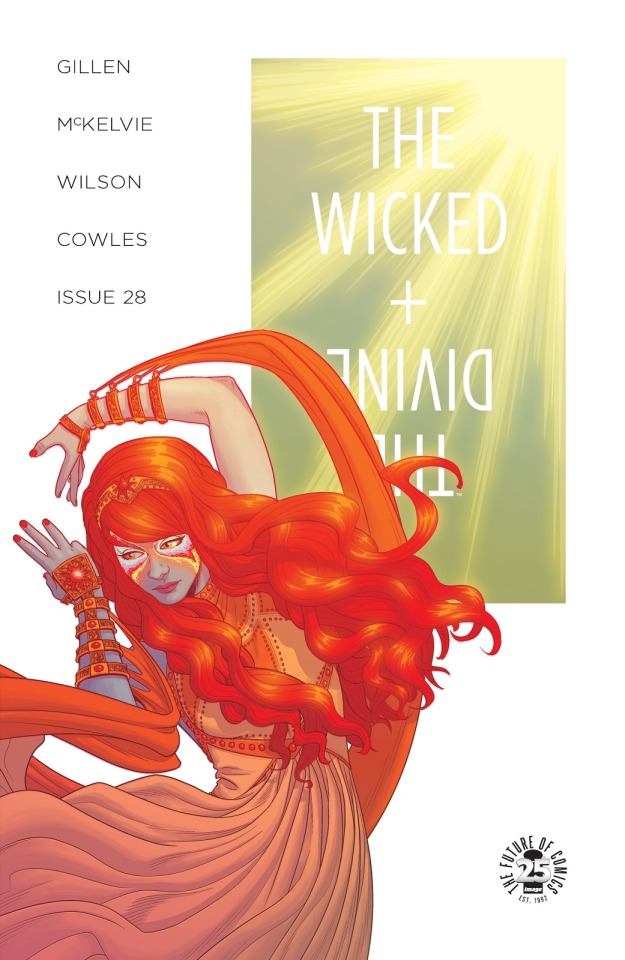
FLOAT LIKE A BUTTERFLY
For me, the beginning of issue 28 especially on reread and knowing a couple of the twists to come is sort of like boxing Ali. Gillen floats around catching you off guard again and again until you’re just sort of dancing there on your own. Not only does David have a son and a long-departed Asian (ahem) wife but his son is Woden (supposedly) (nice job bro) and yet another riff on Larkin playing out. Oh and all of that is a lie, Woden having totally played the moment (and Cassandra) brilliantly with a classic super villain origin story, complete with school for evil geniuses mental institution vibe. And woven in we’ve got this tremendous argument about identity between Woden and Cass which takes everything to such a deeper place.
Each one of those steps is so unexpected and pleasurable as a reader, I find it leaves me less interested in “figuring it all out” (aka trying to assert control) and more interested in just going with it. Woden’s words to Cassandra really are a challenge to us: comic book-as-puzzle readers, screw you.
There is one mystery I can’t let go of, though. Whose room are we in those first pages?

It’s gotta be Jon’s right? We’ve got that poster of a Transformer type robot, the de rigeur poster of women in slinky outfits (do we still say slinky?) and another of a Terminator-like shirtless sunglasses guy with a gun. It all screams teenager.
But that family photo Cass finds there, Jon as a baby with his parents, I don’t know, it seems much more a “parents remembering the beginning of their family” photo than the kind of thing a kid has in his room. Maybe it’s the last picture before David drove Jon’s mom away? Or the only moment of happy family he has?

Or – and this is a reach – could this actually be David’s room? It seems small, admittedly, again much more child’s bedroom than parent’s. But most of those posters absolutely fit Woden’s gross adult-adolescence. (The Transformer not so much, though it, too, is quite an image of male power.) And somehow the idea that this could be Woden’s room makes him even more disturbing than I already had him at, which makes me think it absolutely has to be at the least a space he spends time in and oh God can we please move on?
PREY-ER...
I go back and forth on what exactly Laura has been up to with Sakhmet. She doesn’t want to talk about her feelings, Laura, why do you keep bringing them up? To me, it reads a little like a false lead to keep “But is she the Destroyer for real though?” alive.
Maybe it’s another form of driving your motorcycle into the embankment – I’ll just keep poking the tiger until it rips my throat out and takes me out of my misery?
In this particular issue, though, it’s clear that Laura is also trying to understand the horror she sees herself as having caused/causing. Who better for the Destroyer to hang with than one who destroys. Some dark dark stuff going on there.
...AND PREY

Meanwhile being an unfeeling sex monster is about not getting hurt. Except as it turns out, it’s precisely in bed–and at the hands of Ammy of all people--that Sakhmet is forced to face her own vulnerability.
In his Notes Kieron has really interesting things to say about how he and Jamie think about sex scenes.
In part, those scenes are meant for us to observe, they’re about us watching, and all the chars here are POV, we don’t want them to be the objects of our view.
Also, we don’t learn anything from the sex. We learn from the choice to have sex and how you feel afterwards. So do lots of that.
What I love about having sex be the context here is that it is Sakhmet’s seat of power, the place she feels safest: here she is the mirror that prevents her being seen, the hunter surrounded by prey, and it is here that she ends up being hurt. It’s brilliant. Even as she is completely wrong in her judgment that everyone thinks her a fool and has been laughing behind her back (can you imagine ANYONE EVER laughing at or about Sakhmet except maybe Luci? I mean, those claws...) – in fact the scene reveals that she is indeed a fool, precisely because she has thought she was safe.
At least when all’s been said and done and revealed she takes the time to eat a little something.
AMMENTO MORI
Is it notable that this is the first time we’ve seen an Ammy service since the very first issue? Probably, though they don’t make a point of how Laura’s life has changed since. If anything the comparison is more about how Ammy has changed, how much more confidently unhinged she is. Most specifically...

This sequence is such a fantastic contrast with the pure apotheotic godliness of our first experience of Ammy in in issue one.
In fact, it leaves you wondering what did we even see in her back then. Which I guess in a way is what Laura must be feeling, too...
DEAR DIARY

Obviously there’s a lot to consider in the very fact that Ananke precedes her likely death by writing a heartfelt letter. It tells us there’s someone else out there that not only knows what’s going on but has the power to get involved. Someone who seems to care for her.
Knowing what we know as of a few issues down the road, it’s almost certainly Baal, isn’t it? He’s the one she’s told the most, and manipulated the best.
Of course, there’s also the question that has floated through the series all along like oil scum on a pond, is it possible that Ananke is actually in some awful way a white hat? We’re definitely in the realm of both/and here – you can’t do what she’s done to any of these characters and not be a full and total monster. But it’s hard not to see this private moment and not gain some degree of pathos for the lady. (Dagnab it.)
(Just realized -- is it me or is this also the very first time we’ve seen Ananke without some kind of mask? God, she’s actually being vulnerable here, isn’t she? ARGH. LET ME KEEP MY PREJUDICES.)
3 notes
·
View notes
Text
THE WICKED + THE DIVINE #27: OB-SESSION
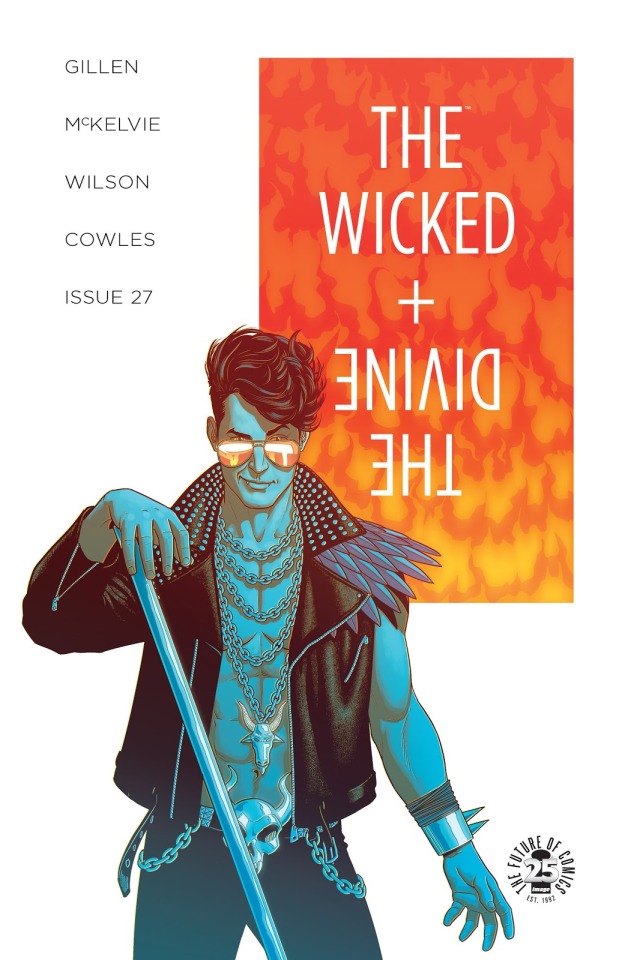
After many months, I’m back! Sorry for the long silence. Life=Crazy=Sorry.
I’m planning over the next couple weeks to post summaries of the rest of Imperial Phase I & II and then hopefully I’ll catch up soon after that. It’s hard to believe there’s only a few more issues left. (Nooooooooooo.)
I’ve actually held off reading the most recent couples issues until I’ve gotten back onto this, so if as we go you’re wondering how it is I don’t already know this or that, that is how. I think the last issue I read had all kinds of crazy reveals about Baal. Speaking of which...
BAALER (I Hate Myself for this Title But There You Are)
The big reveal of issue 27 is that Baal has some kind of magic super secret voodoo he can use to stop the Great Darkness. It builds on last issue, where we learned he’d not only been previously briefed on the GD by Ananke but seen his father murdered by it. It’s also the beginning of another shoe dropping, except we don’t really know what gets squished beneath it for another eight issues and two specials and like a year of reading time so it doesn’t seem like a shoe so much as a hmm, that’s mysterious, I’m sure it’s fine, shall we rave then?
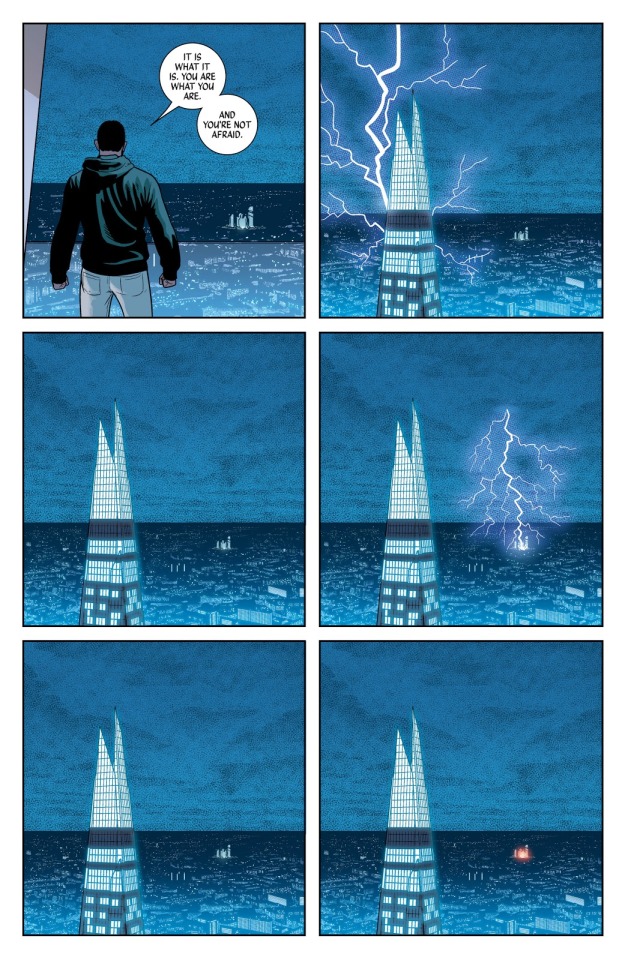
I love the visual structure of this page, the way it uses repetition to express the passage of time and also distance to simultaneously demonstrate our own distance as readers from whatever horrible nightmare things are going on and to minimize those events. (It’s so small; whatever it is, it couldn’t be that bad, could it?)
(Baal, what have you done...)
I also like how Baal’s “reassurance” to Mini repeats his mother’s words from last issue--“It is what it is,” but then adds on in a way that sounds like the sort of ‘steel yourself for nightmares’ mantra learned from everyone’s favorite grandmonster. Even as it gives Baal an adult-sounding stoicism, it also makes him sound like a little boy.
And speaking of Baal’s complicated relationships with children: Had we been told before now that Mini ascended just a month after him? It strikes me as a brilliant move on Ananke’s part. Right from the start she’s set up her replacement self as a little sister for Baal to protect.
Two issues in a row we’ve got Mini as the seeming target of the Great Darkness bug fiesta. Is that because it knows who she really is/will be? Is the GD somehow in league with Ananke, and the attacks on Mini are just another way of keeping everyone thinking of her as Everybody’s Favorite Divine Lil Sis? Or does this, too, have something to do with Baal? Could it be that it’s actually Baal and not Laura that is well and truly cursed?
TOPOGRAPHICAL FLUIDITY
The heart of issue 27 is the five double-page spreads in which the standard left to right, up to down of Western comic storytelling slowly breaks down. On the first splash we’ve got a Laura/Sakhmet story riding the top, then the lower three quarters of each page telling their own stories (though really it’s the continuation of Baal’s story from page one to two). The second spread flips the structural arrangement, but now the left and the runner are continuing a story while on the right page we’re with Laura and Baph and Laura’s sister and ow oh God that hurts to read.
The pages continue to shift and change from there, with one section always following Laura, at least one following Dio/Cass at the rave, and the other one or two checking in on what other characters are up to.
The thing I love about the approach is how it speaks to the disintegration within the group that Laura ordained with her choice of “Anarchy” last issue. We’re not in complete collapse by any means, we can definitely follow the narratives, but the idea that these characters are starting to go in different directions is literally demonstrated in the structure of the page.
And also in the way the pages alter the visual language of Dio’s earlier rave (from issue 8). We’ve got the same 16 block grid structure, but it’s twice as dense; now every block contains an actual story panel, as compared to half for most of 8, with the other half used for the ongoing rave 1-2-3-4 countdowns.
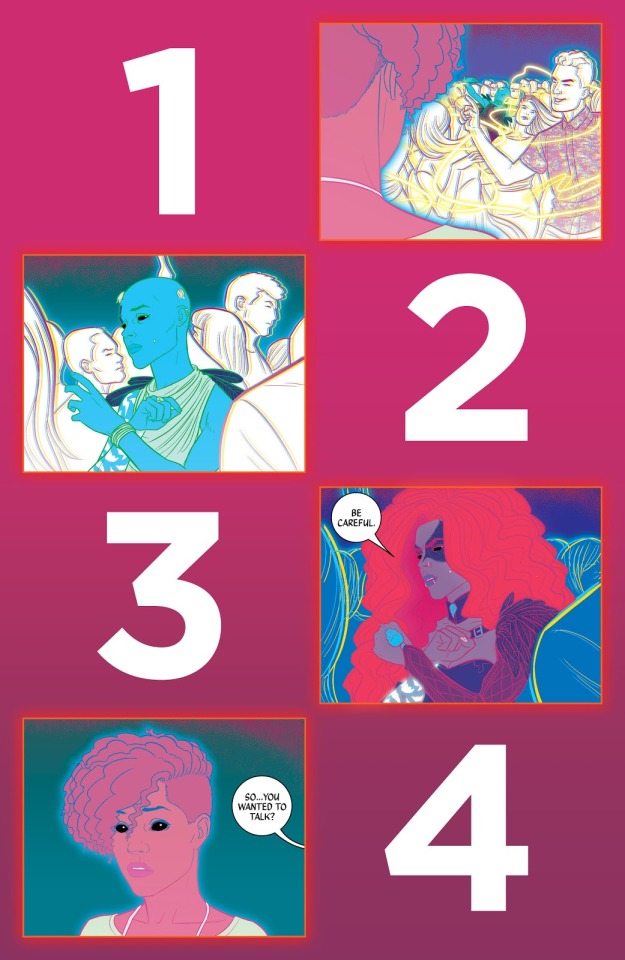
Whereas issue 8′s dance pages had a sort of expansiveness, a sense of the rave as the overriding context that the story panels are just a part of, in 27 we’ve lost all that. In fact the rave is only one small part of what’s going on, even as its grid and color frames remain. (It’s interesting to see the rave visual style used as well for what precedes and follows it; it’s like the energy of the rave is starting to bleed out beyond the confines in which it makes sense.)
It’s also worth noting the rave in issue 8 ends with different members of the Pantheon one after another finishing Dionysius’ sentence, as though all one person. Another great contrast with the never-united narratives of issue 27.
But you know, even seeing how issue 27 offers an intensifying deterioration of the rave joy feel of issue 8, I still easily get lost in the visual dance of its two page spreads. I think it’s those bright frames; they just read to me as “fun”. (Apparently I’d be all good living in a prison camp as long it was decorated with Christmas lights.)
One moment does really snap me out of it, though:

No matter how bad things have gotten, Drunk Child Star Mini feels very unexpected. Plus who is she talking to? The camera team? Herself? Ananke Within?
(Actually, going back to issue 8 I realize we get a similar moment where out of the blue the story cuts to Minerva, talking directly to the camera with that same combination of ‘Don’t mind me.” and “Life sucks.”

So she’s almost certainly talking to their documentary squad.)
Mini drinking is not the worst thing we see in these pages by any means.
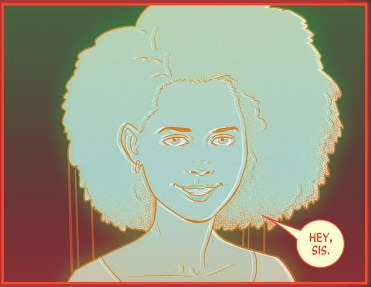
Ow. Ow. Oh God, Oh God it hurts.
But somehow that Mini moment (that mini Mini?) (#sorrynotsorry) is the moment I find most off key.
ONE MORE ONE MORE TIME
Hmm. That comparison between the two Mini moments has got me thinking...
You know, give me a second...
*time passes*
So hey, I’m back. I just went back through the rave in issue 8. Here are some of its major beats:
Dio tries to help Laura let go.
Laura becomes a part of everything going on.
Laura talks about her family and sketches them in light.
Cassandra cannot connect.
Sakhmet and Laura look each over and then start dancing together.
Woden watches.
Mini is left out.
The Morrigan warns Laura about getting too into Baphomet.
Everyone unites around Dio’s thought of making people’s lives better, because the end is coming soon.
Each of those beats is returned to issue 27.
Dio tries to help Cassandra let go.
Laura tries to disconnect from everything that’s happened.
Laura thinks about when she got Baphomet to create an illusion of her family.
Cassandra finally connects, saying “You’re full of stars”, which is what Laura said to her at the rave in issue 8. But then she rejects the connection.
Laura, now with Sakhmet, wonders what’s the worst thing she could do to her.
Woden watches. (Jamie uses the very same image.)
Mini is still left out, and now drinking.
Laura gets too into Baphomet, and now Baphomet is locked away with the Morrigan.
Cassandra rejects the connection.
There’s a little more in each rave than that (Woden plotting, Woden calling for a hook up, Baal and Inanna), but you gotta love the way the parallels show those stories having progressed (and not for the better).
(Also, I know Dio is on life support at this point, but man it feels like there should be one more cast rave, doesn’t it? Jonesing for my rule of threes.)
LOCK STEP
In the final pages we shift to two pages of a sort of call and response; on the left side we get David telling us what’s “really going on”, aka in year two the gods lose it, and on the right we cut back to each god in their own version of doing that, and ending on the punch line of Cassandra.
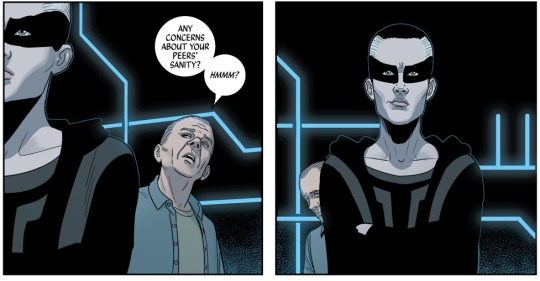
She’s the one god who seems to have her head well and truly on straight, the adult in the room, but here she is just staring silently at what has been her white whale the whole issue, Ananke’s Murderous Mystery Machine.
Gillen’s notes on this moment are familiar, chilling and wonderful:
Comrade Rossignol, my old partner in crime, game developer and co-writer on The Ludocrats, and I have a line we tend to quote to one another. It’s a paraphrase of a quote from Ballard: ‘My advice to anyone in any field is to be faithful to your obsessions. Identify them and be faithful to them, let them guide you like a sleepwalker.’
We quote it as: ‘Stay true to your obsessions and your obsessions will be true to you.’
It’s basically been our respective careers’ magnetic north, but there’s certainly times when I wonder how good it’s proved for us as human beings.
BUT WAIT, THERE’S MORE
You could easily go from Cassandra staring silently up to the spooky final full page spread of her white whale itself. But instead Gillen gives us an extra six panel page first. It seems puzzling; we don’t really need to have David ask “Are you okay?” We already know that Cass isn’t, and that she doesn’t know it.
But for me what makes that page so important is that it gives the other Norns the chance to ask David about their own fate. Imperial Phase I has taken Skuld and Verdandi from silent back-up singers to real emotional partners with Cass, indeed the dominants to her submissive. By presenting us with the question of their fate we’re reminded of the fullness of their humanity; their lives are just as valuable as that of Cass.
Their question also plays very much to Gillen’s comment about the destructive impacts of artistic obsession. These gods don’t just hurt themselves; they put their families, their fans, their friends at risk. What will Skuld and Verdandi do when those dangers come for them, one wonders...?
#wicdiv#kieron gillen#jamie mckelvie#Hoping for a Skuld and Verdandi sitcom spinoff#matt wilson is the god of colors
3 notes
·
View notes